High Impact Tutoring Built By Math Experts
Personalized standards-aligned one-on-one math tutoring for schools and districts
Acute triangles
Here you will learn about acute triangles, including what an acute triangle is and how to solve problems with acute triangles.
Students first learn about acute triangles in the 4 th grade with their work in geometry.
What are acute triangles?
Acute triangles are triangles that have three acute angles. Recall that an acute angle is an angle that has a measure that is greater than 0^{\circ} and less than 90^{\circ}.
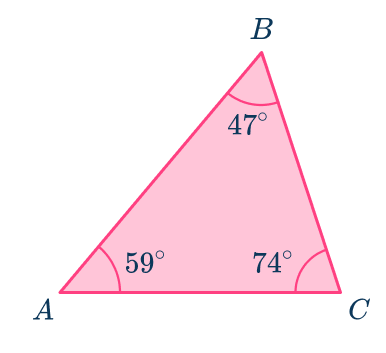
Here is an example of acute triangle ABC, notice how all three angles are acute angles. Notice, how the three interior angles sum to 180^{\circ}. This is true of all triangles regardless if they are acute triangles or not because of the angle sum property.
The interior angles of an acute triangle will always be acute angles.
Acute triangles can be classified into three categories.
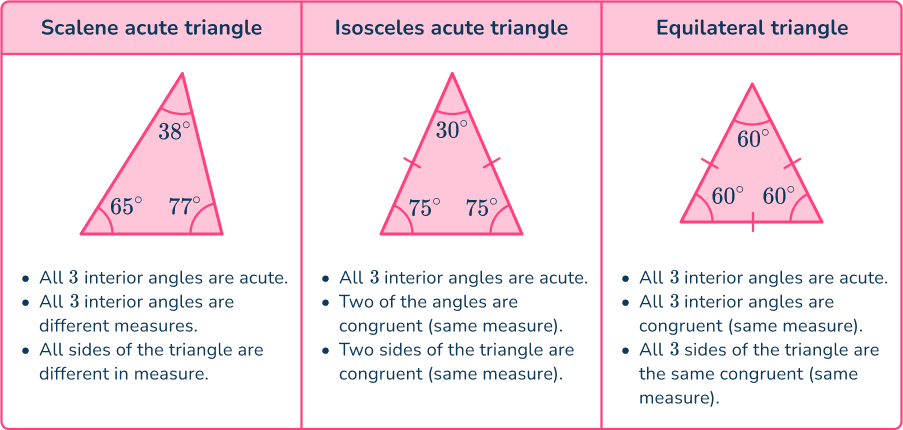
What are acute triangles?
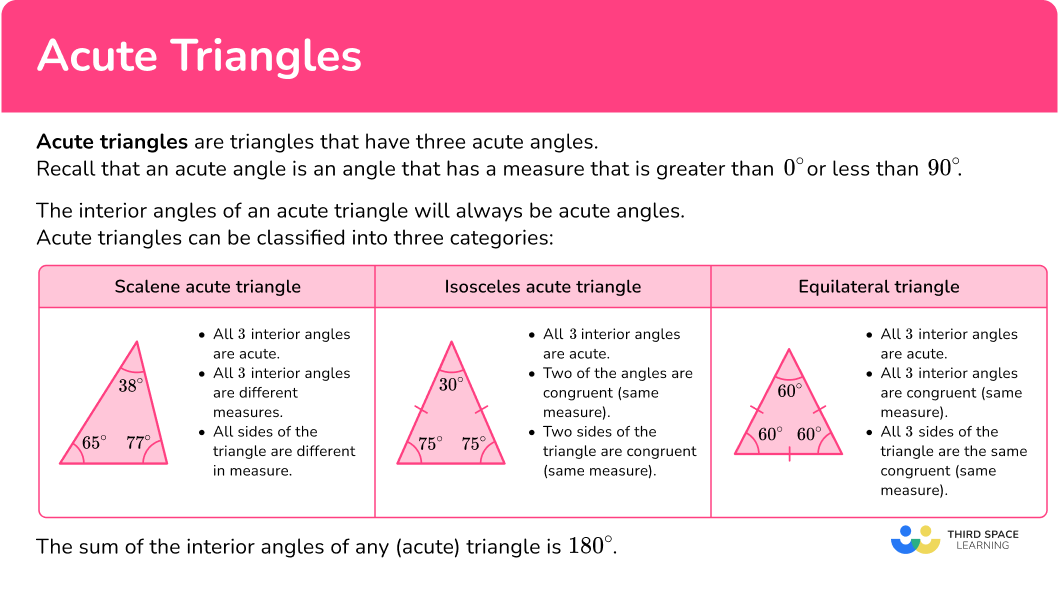
Common Core State Standards
How does this apply to 4 th and 5 th grade math?
- Grade 4 – Geometry (4.G.A.1)
Draw points, lines, line segments, rays, angles (right, acute, obtuse), and perpendicular and parallel lines. Identify these in two-dimensional figures.
- Grade 4 – Geometry (4.G.A.2)
Classify two-dimensional figures based on the presence or absence of parallel or perpendicular lines, or the presence or absence of angles of a specified size. Recognize right triangles as a category, and identify right triangles.
- Grade 5 – Geometry (5.G.B.3)
Understand that attributes belonging to a category of two-dimensional figures also belong to all subcategories of that category.
![[FREE] Triangles Check for Understanding Quiz (Grade 4 to 5)](https://thirdspacelearning.com/wp-content/uploads/2023/07/Triangles-check-for-understanding-quiz-listing-image-.png)
[FREE] Triangles Check for Understanding Quiz (Grade 4 to 5)
![[FREE] Triangles Check for Understanding Quiz (Grade 4 to 5)](https://thirdspacelearning.com/wp-content/uploads/2023/07/Triangles-check-for-understanding-quiz-listing-image-.png)
Use this quiz to check your grade 4 to 5 students’ understanding of triangles. 10+ questions with answers covering a range of 4th and 5th grade triangle topics to identify areas of strength and support!
DOWNLOAD FREE![[FREE] Triangles Check for Understanding Quiz (Grade 4 to 5)](https://thirdspacelearning.com/wp-content/uploads/2023/07/Triangles-check-for-understanding-quiz-listing-image-.png)
[FREE] Triangles Check for Understanding Quiz (Grade 4 to 5)
![[FREE] Triangles Check for Understanding Quiz (Grade 4 to 5)](https://thirdspacelearning.com/wp-content/uploads/2023/07/Triangles-check-for-understanding-quiz-listing-image-.png)
Use this quiz to check your grade 4 to 5 students’ understanding of triangles. 10+ questions with answers covering a range of 4th and 5th grade triangle topics to identify areas of strength and support!
DOWNLOAD FREEHow to solve problems involving acute triangles
In order to identify acute triangles:
- Calculate the interior angle sum / State all interior angles.
- Recall the definition.
- Explain how the triangle fits or does not fit the definition.
Acute triangles examples
Example 1: identifying acute triangles
Determine if the triangle is an acute triangle.
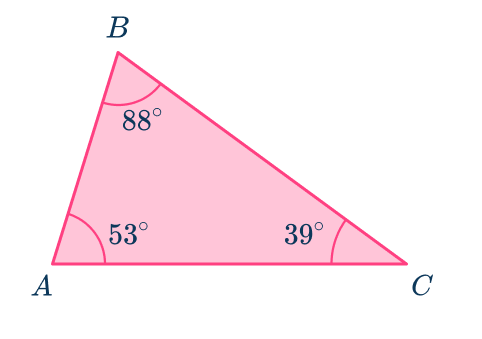
- Calculate the interior angle sum.
The sum of interior angles is 180^{\circ} , so this triangle can exist.
2Recall the definition.
An acute triangle is a triangle where all three interior angles have a measure between 0^{\circ} and 90^{\circ}.
3Explain how the triangle fits or does not fit the definition.
In this case, the angle measurements are 88^{\circ},~39^{\circ}, and 53^{\circ}. All three of these angles fall in the range 0^{\circ}<\theta<90^{\circ}, so the triangle is an acute triangle.
Example 2: identifying acute triangles
Determine if the triangle ABC is an acute triangle.
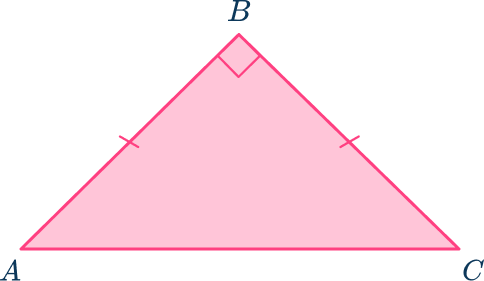
Calculate the interior angle sum / State all interior angles.
The triangle ABC is isosceles as two sides are the same length. The interior angle at B=90^{\circ} and the remaining two angles are equal:
(180-90)\div{2}=45^{\circ}
So A=45^{\circ},~B=90^{\circ}, and C=45^{\circ}.
Recall the definition.
An acute triangle is a triangle where all three interior angles have a measure between 0^{\circ} and 90^{\circ}.
Explain how the triangle fits or does not fit the definition.
In this case, the angle measurements are 45^{\circ},~90^{\circ}, and 45^{\circ}. The right-angle does not fall in the range 0^{\circ}<\theta<90^{\circ} as the upper limit is equal to 90^{\circ}, so the triangle is not an acute triangle.
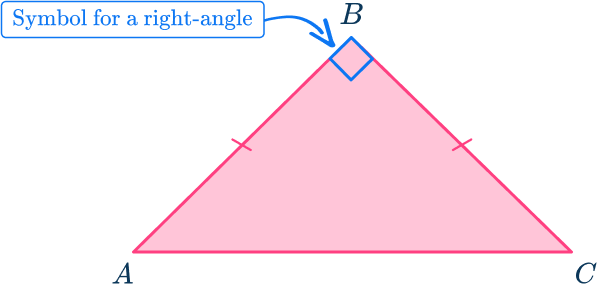
Example 3: identifying acute triangles
Jillian calculated the angles of a triangle to be: 53^{\circ},~55^{\circ}~74^{\circ}. Is the triangle an acute triangle?
Calculate the interior angle sum / State all interior angles.
The sum of interior angles is 182^{\circ}, so the angles have not been measured correctly.
This triangle cannot be drawn so it is not an acute triangle.
Example 4: classify the type of acute triangle
What type of acute triangle is represented by the triangle below?
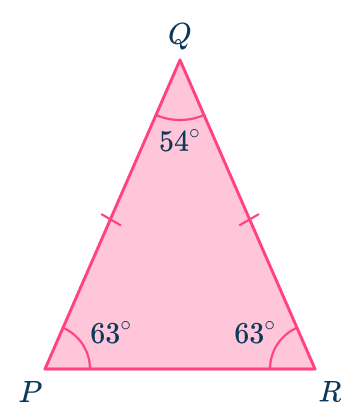
Calculate the interior angle sum.
The sum of interior angles is 180^{\circ} , so this triangle can exist.
Recall the definition.
An acute triangle is a triangle where all three interior angles have a measure between 0^{\circ} and 90^{\circ}.
Explain how the triangle fits or does not fit the definition.
In this case, the angle measurements are 63^{\circ},~54^{\circ}, and 63^{\circ}. All three of these angles fall in the range 0^{\circ}<\theta<90^{\circ}, so the triangle is an acute triangle.
As two of the angles are the same, and two sides are the same length, this is an isosceles acute triangle.
Example 5: determining the type of acute triangle
Dara makes the claim that an equilateral triangle is an acute triangle and Julie makes the claim that an equilateral triangle is not an acute triangle. Who is correct, Dara or Julie?
Calculate the interior angle sum / State all interior angles.
Each interior angle of an equilateral triangle is 60^{\circ}.
Recall the definition.
An acute triangle is a triangle where all three interior angles have a measure between 0^{\circ} and 90^{\circ}.
Explain how the triangle fits or does not fit the definition.
In this case, the angle measurements are 60^{\circ},~60^{\circ}, and 60^{\circ}. All three of these angles fall in the range 0^{\circ}<\theta<90^{\circ}, so the triangle is an acute triangle.
Dara is correct.
Example 6: determine what type of acute triangle
What type of acute triangle is the triangle below?
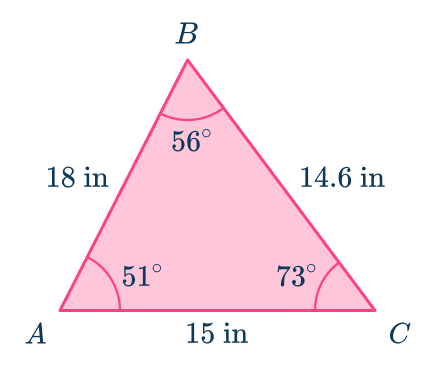
Calculate the interior angle sum.
The sum of interior angles is 180^{\circ} , so this triangle can exist.
Recall the definition.
An acute triangle is a triangle where all three interior angles have a measure between 0^{\circ} and 90^{\circ}.
Explain how the triangle fits or does not fit the definition.
In this case, the angle measurements are 56^{\circ},~51^{\circ}, and 73^{\circ}. All three of these angles fall in the range 0^{\circ}<\theta<90^{\circ}, so the triangle is an acute triangle.
The three acute angles and three side lengths are different, so this is an acute scalene triangle.
Teaching tips for types of triangles
- Have students use manipulatives to investigate triangle properties.
- Use different sized toothpicks or straws as a way for students to build understanding of the classification of triangles.
- Although worksheets provide students with an opportunity to practice skills, using activities that require students to use rulers and protractors to sketch the triangles will help them formulate understanding of the triangle classifications.
- Facilitate learning opportunities like projects where students can see how acute triangles are used in the real world.
Easy mistakes to make
- Angles in triangles
Make sure you know your angle properties. Getting these confused causes quite a few misconceptions.- Acute angles are greater than 0^{\circ} or less than 90^{\circ}
- Right angles are equal to 90^{\circ}
- Obtuse angles are greater than 90^{\circ} and less than 180^{\circ}
- Reflex angles are greater than 180^{\circ}
- Incorrect assumptions for triangles
Assuming that an isosceles triangle is also equilateral is an incorrect assumption. Equilateral triangles are also considered isosceles triangles because they contain two equal sides.
Related triangle lessons
Practice acute triangle questions
1. What type of triangle is ABC?
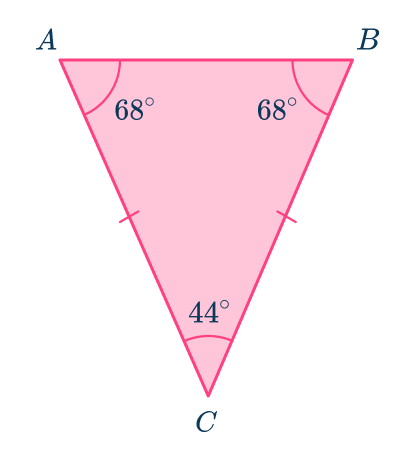
Acute isosceles triangle

Acute scalene triangle

Equilateral triangle

Obtuse angled triangle

The sum of interior angles is 68+68+44=180^{\circ} so this triangle can exist.
The angle measures of each of the three interior angles are: 68^{\circ},~68^{\circ},~44^{\circ} which are all acute angles.
Two of the angle measures are the same and the triangle is marked with two side measurements being the same. So, the triangle is an acute isosceles triangle.
2. Taylor claims that a triangle that has three interior angles that measure 60^{\circ},~60^{\circ},~60^{\circ} is an equilateral triangle. Travis claims that a triangle that has three interior angles that measure 60^{\circ},~60^{\circ},~60^{\circ} is an acute triangle. Who is correct?
Taylor is correct

Travis is correct

They are both correct

They are both incorrect

An equilateral triangle has three interior angles that measure 60^{\circ},~60^{\circ},~60^{\circ}, each of the angles are acute because the angles fall in the range of 0^{\circ} and less than 90^{\circ}.
So, the triangle is considered to be an acute triangle and an equilateral triangle. Both Taylor and Travis are correct.
3. Classify the triangle below.

Right triangle

Equilateral triangle

Acute triangle

Impossible triangle

The sum of interior angles is 42+82+58=182^{\circ} , this triangle cannot exist, so the triangle is an impossible triangle.
4. Classify triangle ABC.
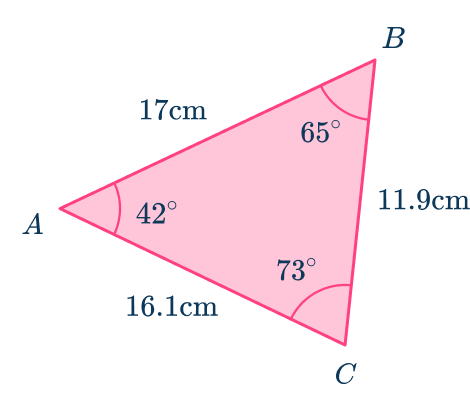
Impossible triangle

Acute scalene triangle

Acute isosceles triangle

Obtuse scalene triangle

42+65+73=180^{\circ} , so this triangle can exist.
The triangle does not have any side lengths that are equal, and the interior angles are:
42^{\circ},~65^{\circ}, and 73^{\circ} , which are all acute angles in the range 0^{\circ}<\theta<90^{\circ} , and they are not equal to each other, so this is an acute scalene triangle.
5. Mike is a recreational pilot. He likes to fly a path from his hometown of Hazlet to Sandy Hook to Freehold and then back to Hazlet. Mike’s flight path is pictured below. What type of triangle does his flight path make?
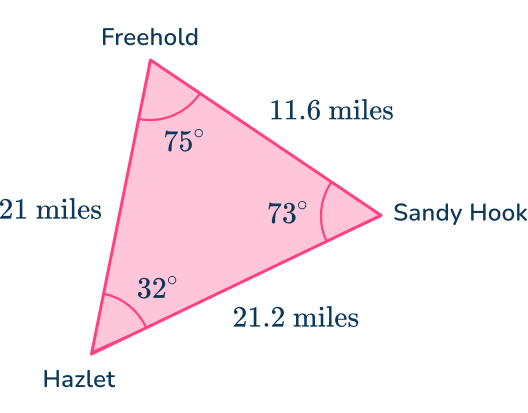
Acute isosceles triangle

Acute right triangle

Obtuse triangle

Acute scalene triangle

The flight path makes a triangle that has three different side length measurements and three different angle measurements.
75+73+32=180^{\circ} so the triangle is possible.
Also, each of the angle measurements of 75^{\circ},~73^{\circ}, and 32^{\circ} are acute angles (0^{\circ}<\theta<90^{\circ}) , so the triangle is an acute scalene triangle.
6. Billy measures the side lengths of a triangle to be 20\mathrm{~cm},~20\mathrm{~cm}, and 3.49\mathrm{~cm}. He measures the angles to be 85^{\circ},~85^{\circ},~10^{\circ}. What is the classification of this triangle?
Acute isosceles triangle

Obtuse isosceles triangle

Right isosceles triangle

Equilateral triangle

The triangle has two side measurements that are equal and two angle measurements that are equal, so it is isosceles.
Each of the angle measurements are acute angles because they fall in the range 0^{\circ}<\theta<90^{\circ} , so it is an acute isosceles triangle.
Types of triangles FAQs
No, triangles can only have 1 obtuse angle because the sum of the interior angles of a triangle equal 180^{\circ}. If there was more than 1 obtuse angle in the triangle, the sum would be greater than 180^{\circ}.
Yes, they mean the same thing which is a triangle with three acute angles and sides having different lengths.
No, triangles can’t be classified as both acute and obtuse because definition of an acute triangle is a triangle with 3 acute angles and the definition of an obtuse triangle is one that has 1 obtuse angle.
Heron’s formula is a formula that calculates the area of a triangle without having to know the height of the triangle.
\text {Area}=s\sqrt{(s-a)(s-b)(s-c)} where s is the semi-perimeter and a, \, b, \, c represent the length of the sides.
The centroid of a triangle is considered to be the balancing point of the triangle. It’s the concurrent point where all the medians of a triangle meet inside the triangle. The median of a triangle is a line segment that connects the vertices to the midpoint of the opposite side.
The circumcenter of a triangle is the concurrent point where all the perpendicular bisectors of a triangle meet and it is equal in distance from each of the vertices of the triangle. It is also the center of the circumscribed circle.
The incenter is the concurrent point where all the angle bisectors meet and is equal in distance from each side of the triangle. It is also the center of the inscribed circle.
Yes, you can find the area of an acute triangle that has fraction side lengths as long as you know the measurement of the base of the triangle. Be sure to have the area dimension in square units.
Yes, triangles have interior and exterior angles. The exterior angle is supplementary with the interior angle.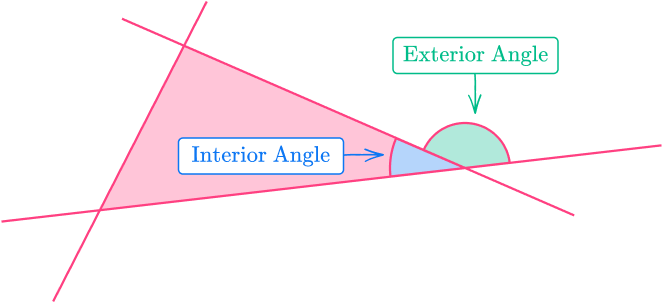
The next lessons are
Still stuck?
At Third Space Learning, we specialize in helping teachers and school leaders to provide personalized math support for more of their students through high-quality, online one-on-one math tutoring delivered by subject experts.
Each week, our tutors support thousands of students who are at risk of not meeting their grade-level expectations, and help accelerate their progress and boost their confidence.

Find out how we can help your students achieve success with our math tutoring programs.
[FREE] Common Core Practice Tests (3rd to 8th Grade)
Prepare for math tests in your state with these 3rd Grade to 8th Grade practice assessments for Common Core and state equivalents.
Get your 6 multiple choice practice tests with detailed answers to support test prep, created by US math teachers for US math teachers!